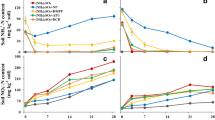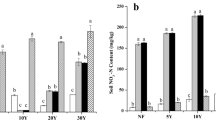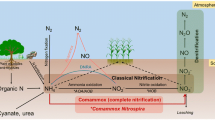Abstract
Purpose
The compounds 1-octyne and 2-phenyl-4,4,5,5-tetramethylimidazoline-1-oxyl 3-oxide (PTIO) are frequently used as nitrification inhibitors for ammonia-oxidizing bacteria (AOB) and archaea (AOA), respectively, but their influence on comammox Nitrospira remains unclear. In this study, we examine how will 1-octyne and PTIO influence AOA, AOB, and comammox Nitrospira in an acidic Ultisol. The results will provide guidance for the nitrification inhibitor selections in the relevant research and field management practices.
Materials and methods
We carried out a microcosm experiment using acetylene, 1-octyne, and PTIO as nitrification inhibitors to investigate their effects on ammonia oxidizers, especially comammox Nitrospira. The abundance of ammonia oxidizers was determined by real-time quantitative PCR while the community structure of comammox Nitrospira was examined by Illumina MiSeq sequencing.
Results and discussion
Acetylene, 1-octyne, and PTIO significantly reduced the net nitrification rate, with a more pronounced effect observed for acetylene and 1-octyne amendments. The addition of 1-octyne suppressed the growth of comammox Nitrospira clade A, indicating that 1-octyne was not an exclusive inhibitor for AOB in the acidic Ultisols. Moreover, PTIO reduced the abundance of AOB and comammox Nitrospira clade A, rather than that of AOA, suggesting that AOB and comammox Nitrospira were more sensitive than AOA to the PTIO inhibition in the tested soils. Acetylene, 1-octyne, and PTIO did not show observed changes to comammox Nitrospira community structure.
Conclusions
We provide novel evidence that 1-octyne and PTIO can significantly inhibit the growth of comammox Nitrospira, but have no significant effects on their community structure in the acidic Ultisols. Our findings have implications for proper selection of nitrification inhibitors 1-octyne and PTIO in both laboratory experiments and field practices.




Similar content being viewed by others
References
Alvear M, Rosas A, Rouanet J, Borie F (2005) Effects of three soil tillage systems on some biological activities in an Ultisol from southern Chile. Soil till Res 82:195–202. https://doi.org/10.1016/j.still.2004.06.002
Caporaso JG, Kuczynski J, Stombaugh J, Bittinger K, Bushman FD, Costello EK, Fierer N, Peña AG, Goodrich JK, Gordon JI, Huttley GA, Kelley ST, Knights D, Koenig JE, Ley RE, Lozupone CA, McDonald D, Muegge BD, Pirrung M, Reeder J, Sevinsky JR, Turnbaugh PJ, Walters WA, Widmann J, Yatsunenko T, Zaneveld J, Knight R (2010) QIIME allows analysis of high-throughput community sequencing data. Nat Methods 7:335–336. https://doi.org/10.1038/nmeth.f.303
Daims H, Lebedeva EV, Pjevac P, Han P, Herbold C, Albertsen M, Jehmlich N, Palatinszky M, Vierheilig J, Bulaev A (2015) Complete nitrification by Nitrospira bacteria. Nature 528:504–509. https://doi.org/10.1038/nature16461
Duan C, Wan S, Fan J, Ye G, Lin Y, He JZ (2022) Effects of long−term pig manure applications on the abundance of comammox bacteria in an Ultisol. Acta Ecol Sin. https://doi.org/10.5846/stxb202107031772
Duan P, Fan C, Zhang Q, Xiong Z (2019) Overdose fertilization induced ammonia-oxidizing archaea producing nitrous oxide in intensive vegetable fields. Sci Total Environ 650:1787–1794. https://doi.org/10.1016/j.scitotenv.2018.09.341
Duan P, Wu Z, Zhang Q, Fan C, Xiong Z (2018) Thermodynamic responses of ammonia-oxidizing archaea and bacteria explain N2O production from greenhouse vegetable soils. Soil Biol Biochem 120:37–47. https://doi.org/10.1016/j.soilbio.2018.01.027
Fu Q, Clark IM, Zhu J, Hu H, Hirsch PR (2018) The short-term effects of nitrification inhibitors on the abundance and expression of ammonia and nitrite oxidizers in a long-term field experiment comparing land management. Biol Fert Soils 54:163–172. https://doi.org/10.1007/s00374-017-1249-2
He JZ, Hu HW, Zhang LM (2012) Current insights into the autotrophic thaumarchaeal ammonia oxidation in acidic soils. Soil Biol Biochem 55:146–154. https://doi.org/10.1016/j.soilbio.2012.06.006
He S, Li Y, Mu H, Zhao Z, Wang J, Liu S, Sun Z, Zheng M (2021) Ammonium concentration determines differential growth of comammox and canonical ammonia-oxidizing prokaryotes in soil microcosms. Appl Soil Ecol 157:103776. https://doi.org/10.1016/j.apsoil.2020.103776
He ZY, Sun A, Jiao XY, Ge AH, Hu HW, Jin S, Liu X, Lin Y, He JZ (2022) Fertilization has a greater effect than rhizosphere on community structures of comammox Nitrospira in an alkaline agricultural soil. Appl Soil Ecol 175:104456. https://doi.org/10.1016/j.apsoil.2022.104456
Herbold CW, Lehtovirta-Morley LE, Jung MY, Jehmlich N, Hausmann B, Han P, Loy A, Pester M, Sayavedra-Soto LA, Rhee SK, Prosser JI, Nicol GW, Wagner M, Gubry-Rangin C (2017) Ammonia-oxidising archaea living at low pH: Insights from comparative genomics. Environ Microbiol 19:4939–4952. https://doi.org/10.1111/1462-2920.13971
Hink L, Nicol GW, Prosser JI (2017) Archaea produce lower yields of N2O than bacteria during aerobic ammonia oxidation in soil. Environ Microbiol 19:4829–4837. https://doi.org/10.1111/1462-2920.13282
Hu HW, Zhang LM, Dai Y, Di HJ, He JZ (2013) pH-dependent distribution of soil ammonia oxidizers across a large geographical scale as revealed by high-throughput pyrosequencing. J Soil Sediment 13:1439–1449. https://doi.org/10.1007/s11368-013-0726-y
Kits KD, Jung MY, Vierheilig J, Pjevac P, Sedlacek CJ, Liu S, Herbold C, Stein LY, Richter A, Wissel H (2019) Low yield and abiotic origin of N2O formed by the complete nitrifier Nitrospira inopinata. Nat Commun 10:1–12. https://doi.org/10.1038/s41467-019-09790-x
Kits KD, Sedlacek CJ, Lebedeva EV, Han P, Bulaev A, Pjevac P, Daebeler A, Romano S, Albertsen M, Stein LY, Daims H, Wagner M (2017) Kinetic analysis of a complete nitrifier reveals an oligotrophic lifestyle. Nature 549:269–272. https://doi.org/10.1038/nature23679
Kozlowski JA, Stieglmeier M, Schleper C, Klotz MG, Stein LY (2016) Pathways and key intermediates required for obligate aerobic ammonia-dependent chemolithotrophy in bacteria and Thaumarchaeota. ISME J 10:1836–1845. https://doi.org/10.1038/ismej.2016.2
Kumar S, Stecher G, Li M, Knyaz C, Tamura K (2018) MEGA X: molecular evolutionary genetics analysis across computing platforms. Mol Biol Evol 35:1547–1549. https://doi.org/10.1093/molbev/msy096
Li C, He ZY, Hu HW, He JZ (2022) Niche specialization of comammox Nitrospira in terrestrial ecosystems: Oligotrophic or copiotrophic? Crit Rev Env Sci Tec. https://doi.org/10.1080/10643389.2022.2049578
Li C, Hu HW, Chen QL, Chen D, He JZ (2019) Comammox Nitrospira play an active role in nitrification of agricultural soils amended with nitrogen fertilizers. Soil Biol Biochem 138:107609. https://doi.org/10.1016/j.soilbio.2019.107609
Li Y, Chapman SJ, Nicol GW, Yao H (2018) Nitrification and nitrifiers in acidic soils. Soil Biol Biochem 116:290–301. https://doi.org/10.1016/j.soilbio.2017.10.023
Lin Y, Fan J, Hu HW, Duan C, Ye G, Wan S, He ZY, Zheng Y, He JZ (2022) Differentiation of individual clusters of comammox Nitrospira in an acidic Ultisol following long-term fertilization. Appl Soil Ecol 170:104267. https://doi.org/10.1016/j.apsoil.2021.104267
Lin Y, Hu HW, Ye G, Fan J, Ding W, He ZY, Zheng Y, He JZ (2021) Ammonia-oxidizing bacteria play an important role in nitrification of acidic soils: a meta-analysis. Geoderma 404:115395. https://doi.org/10.1016/j.geoderma.2021.115395
Lin Y, Ye G, Liu D, Ledgard S, Luo J, Fan J, Yuan J, Chen Z, Ding W (2018) Long-term application of lime or pig manure rather than plant residues suppressed diazotroph abundance and diversity and altered community structure in an acidic Ultisol. Soil Biol Biochem 123:218–228. https://doi.org/10.1016/j.soilbio.2018.05.018
Lu X, Taylor AE, Myrold DD, Neufeld JD (2020) Expanding perspectives of soil nitrification to include ammonia-oxidizing archaea and comammox bacteria. Soil Sci Soc Am J 84:287–302
Martikainen PJ (2022) Heterotrophic nitrification – an eternal mystery in the nitrogen cycle. Soil Biol Biochem 168:108611. https://doi.org/10.1002/saj2.20029
Meinhardt KA, Stopnisek N, Pannu MW, Strand SE, Fransen SC, Casciotti KL, Stahl DA (2018) Ammonia-oxidizing bacteria are the primary N2O producers in an ammonia-oxidizing archaea dominated alkaline agricultural soil. Environ Microbiol 20:2195–2206. https://doi.org/10.1111/1462-2920.14246
Mushinski RM, Phillips RP, Payne ZC, Abney RB, Jo I, Fei S, Pusede SE, White JR, Rusch DB, Raff JD (2019) Microbial mechanisms and ecosystem flux estimation for aerobic NOy emissions from deciduous forest soils. Proc Natl Acad Sci USA 116:2138–2145. https://doi.org/10.1073/pnas.1814632116
Nardi P, Laanbroek HJ, Nicol GW, Renella G, Cardinale M, Pietramellara G, Weckwerth W, Trinchera A, Ghatak A, Nannipieri P (2020) Biological nitrification inhibition in the rhizosphere: Determining interactions and impact on microbially mediated processes and potential applications. FEMS Microbiol Rev 44:874–908. https://doi.org/10.1093/femsre/fuaa037
Nicol GW, Leininger S, Schleper C, Prosser JI (2008) The influence of soil pH on the diversity, abundance and transcriptional activity of ammonia oxidizing archaea and bacteria. Environ Microbiol 10:2966–2978. https://doi.org/10.1111/j.1462-2920.2008.01701.x
Norton J, Ouyang Y (2019) Controls and adaptive management of nitrification in agricultural soils. Front Microbiol 10:1931. https://doi.org/10.3389/fmicb.2019.01931
Osburn ED, Barrett JE (2020) Abundance and functional importance of complete ammonia-oxidizing bacteria (comammox) versus canonical nitrifiers in temperate forest soils. Soil Biol Biochem 145:107801. https://doi.org/10.1016/j.soilbio.2020.107801
Ouyang Y, Norton JM, Stark JM, Reeve JR, Habteselassie MY (2016) Ammonia-oxidizing bacteria are more responsive than archaea to nitrogen source in an agricultural soil. Soil Biol Biochem 96:4–15. https://doi.org/10.1016/j.soilbio.2016.01.012
Picone N, Pol A, Mesman R, van Kessel M, Cremers G, van Gelder AH, van Alen TA, Jetten MSM, Lucker S, Op den Camp HJM (2021) Ammonia oxidation at pH 2.5 by a new gammaproteobacterial ammonia-oxidizing bacterium. ISME J 15:1150–1164. https://doi.org/10.1038/s41396-020-00840-7
Sakoula D, Koch H, Frank J, Jetten MSM, van Kessel M, Lucker S (2021) Enrichment and physiological characterization of a novel comammox Nitrospira indicates ammonium inhibition of complete nitrification. ISME J 15:1010–1024. https://doi.org/10.1038/s41396-020-00827-4
Sauder LA, Ross AA, Neufeld JD (2016) Nitric oxide scavengers differentially inhibit ammonia oxidation in ammonia-oxidizing archaea and bacteria. FEMS Microbiol Lett 363:fnw052. https://doi.org/10.1093/femsle/fnw052
Siljanen HM, Alves RJ, Ronkainen JG, Lamprecht RE, Bhattarai HR, Bagnoud A, Marushchak ME, Martikainen PJ, Schleper C, Biasi C (2019) Archaeal nitrification is a key driver of high nitrous oxide emissions from arctic peatlands. Soil Biol Biochem 137:107539. https://doi.org/10.1016/j.soilbio.2019.107539
Sun P, Zhang S, Wu Q, Zhu P, Ruan Y, Wang Q (2021) pH and ammonium concentration are dominant predictors of the abundance and community composition of comammox bacteria in long-term fertilized Mollisol. Appl Soil Ecol 168:104139. https://doi.org/10.1016/j.apsoil.2021.104139
Tan C, Yin C, Li W, Fan X, Jiang Y, Liang Y (2022) Comammox Nitrospira play a minor role in N2O emissions from an alkaline arable soil. Soil Biol Biochem 171:108720. https://doi.org/10.1016/j.soilbio.2022.108720
Taylor AE, Giguere AT, Zoebelein CM, Myrold DD, Bottomley PJ (2017) Modeling of soil nitrification responses to temperature reveals thermodynamic differences between ammonia-oxidizing activity of archaea and bacteria. ISME J 11:896–908. https://doi.org/10.1038/ismej.2016.179
Taylor AE, Zeglin LH, Wanzek TA, Myrold DD, Bottomley PJ (2012) Dynamics of ammonia-oxidizing archaea and bacteria populations and contributions to soil nitrification potentials. ISME J 6:2024–2032. https://doi.org/10.1038/ismej.2012.51
Trivedi C, Reich PB, Maestre FT, Hu HW, Singh BK, Delgado-Baquerizo M (2019) Plant-driven niche differentiation of ammonia-oxidizing bacteria and archaea in global drylands. ISME J 13:2727–2736. https://doi.org/10.1038/s41396-019-0465-1
Tzanakakis VA, Taylor AE, Bakken LR, Bottomley PJ, Myrold DD, Dörsch P (2019) Relative activity of ammonia oxidizing archaea and bacteria determine nitrification-dependent N2O emissions in Oregon forest soils. Soil Biol Biochem 139:107612. https://doi.org/10.1016/j.soilbio.2019.107612
Uwah D, Iwo G (2011) Effectiveness of organic mulch on the productivity of maize (Zea mays L.) and weed growth. J Anim Plant Sci 21:525–530
Verhamme DT, Prosser JI, Nicol GW (2011) Ammonia concentration determines differential growth of ammonia-oxidising archaea and bacteria in soil microcosms. ISME J 5:1067–1071. https://doi.org/10.1038/ismej.2010.191
Wang J, Wang J, Rhodes G, He JZ, Ge Y (2019a) Adaptive responses of comammox Nitrospira and canonical ammonia oxidizers to long-term fertilizations: Implications for the relative contributions of different ammonia oxidizers to soil nitrogen cycling. Sci Total Environ 668:224–233. https://doi.org/10.1016/j.scitotenv.2019.02.427
Wang X, Wang S, Jiang Y, Zhou J, Han C, Zhu G (2020) Comammox bacterial abundance, activity, and contribution in agricultural rhizosphere soils. Sci Total Environ 727:138563. https://doi.org/10.1016/j.scitotenv.2020.138563
Wang Z, Cao Y, Zhu-Barker X, Nicol GW, Wright AL, Jia Z, Jiang X (2019b) Comammox Nitrospira clade B contributes to nitrification in soil. Soil Biol Biochem 135:392–395. https://doi.org/10.1016/j.soilbio.2019.06.004
Xia F, Wang JG, Zhu T, Zou B, Rhee SK, Quan ZX (2018) Ubiquity and diversity of complete ammonia oxidizers (comammox). Appl Environ Microbiol 84:e01390-e1418. https://doi.org/10.1128/AEM.01390-18
Xiao H, Schaefer DA, Yang X (2017) pH drives ammonia oxidizing bacteria rather than archaea thereby stimulate nitrification under Ageratina adenophora colonization. Soil Biol Biochem 114:12–19. https://doi.org/10.1016/j.soilbio.2017.06.024
Ye G, Fan J, Hu HW, Chen J, Zhong X, Chen J, Wang D, Wei X, Lin Y (2022) Short-term cellulose addition decreases microbial diversity and network complexity in an Ultisol following 32-year fertilization. Agric Ecosyst Environ 325:107744. https://doi.org/10.1016/j.agee.2021.107744
Zhong W, Bian B, Gao N, Min J, Shi W, Lin X, Shen W (2016) Nitrogen fertilization induced changes in ammonia oxidation are attributable mostly to bacteria rather than archaea in greenhouse-based high N input vegetable soil. Soil Biol Biochem 93:150–159. https://doi.org/10.1016/j.soilbio.2015.11.003
Zhou X, Wang S, Ma S, Zheng X, Wang Z, Lu C (2020) Effects of commonly used nitrification inhibitors—dicyandiamide (DCD), 3,4-dimethylpyrazole phosphate (DMPP), and nitrapyrin—on soil nitrogen dynamics and nitrifiers in three typical paddy soils. Geoderma 380:114637. https://doi.org/10.1016/j.geoderma.2020.114637
Acknowledgements
We are grateful to Yingtan National Agro-ecosystem Field Experiment Station for providing soil samples.
Funding
This work was financially supported by the National Natural Science Foundation of China (42077041, 41930756).
Author information
Authors and Affiliations
Corresponding author
Ethics declarations
Conflict of interest
The authors declare no competing interests.
Additional information
Responsible editor: Bin Ma
Publisher's Note
Springer Nature remains neutral with regard to jurisdictional claims in published maps and institutional affiliations.
Supplementary Information
Below is the link to the electronic supplementary material.
Rights and permissions
Springer Nature or its licensor (e.g. a society or other partner) holds exclusive rights to this article under a publishing agreement with the author(s) or other rightsholder(s); author self-archiving of the accepted manuscript version of this article is solely governed by the terms of such publishing agreement and applicable law.
About this article
Cite this article
Lin, Y., Duan, C., Fan, J. et al. Nitrification inhibitor 1-octyne inhibits growth of comammox Nitrospira but does not alter their community structure in an acidic soil. J Soils Sediments 23, 989–997 (2023). https://doi.org/10.1007/s11368-022-03367-w
Received:
Accepted:
Published:
Issue Date:
DOI: https://doi.org/10.1007/s11368-022-03367-w




